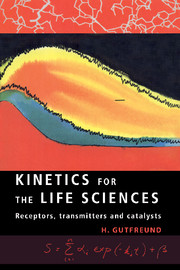Book contents
- Frontmatter
- Contents
- Preface
- 1 The time scales of nature: a historical survey
- 2 Some mathematical introductions
- 3 Elementary kinetic equations: ground rules
- 4 Kinetic analysis of complex reactions
- 5 Transient kinetics of enzyme reactions
- 6 Chemical relaxation phenomena
- 7 Factors affecting rates of reactions
- 8 The role of light in kinetic investigations
- References
- Index
5 - Transient kinetics of enzyme reactions
Published online by Cambridge University Press: 08 January 2010
- Frontmatter
- Contents
- Preface
- 1 The time scales of nature: a historical survey
- 2 Some mathematical introductions
- 3 Elementary kinetic equations: ground rules
- 4 Kinetic analysis of complex reactions
- 5 Transient kinetics of enzyme reactions
- 6 Chemical relaxation phenomena
- 7 Factors affecting rates of reactions
- 8 The role of light in kinetic investigations
- References
- Index
Summary
Kinetic identification of reaction intermediates
Single and multiple turnover of enzyme reactions
For the purpose of the present discussion the term ‘transient kinetics’ is applied to the time course of a reaction from the moment when enzyme and substrate are mixed, t = 0, until either a steady state or equilibrium is established. The difference between the kinetic problems discussed in section 3.3 and in the present section is, respectively, the presence of catalytic as distinct from catalytic concentrations of enzyme. Here we are concerned with the stoichiometry of enzyme states. Transient kinetic experiments with enzymes can be divided into two types. The first of these (multiple turnover) is carried out under the condition that the initial concentrations of substrate and enzyme are cs(0)»cE(0) and cs(t) can, therefore, be regarded as constant throughout the course of the reaction until a steady state is attained. Alternatively, in a single turnover reaction, when cs(0)≤cE(0), the transient formation and decay of reaction intermediates is observed until the overall process is essentially complete. These two possibilities will be illustrated with specific examples. In connection with a discussion of the approach to the steady state, in section 3.3 it was emphasized that, at t = 0, the concentrations of the intermediates, enzyme–substrate and enzyme–product complexes, are zero and, therefore, the rate of product formation is also zero. Under the experimental conditions used for steady state rate measurements and for enzyme assays, the first few seconds after the initiation of a reaction are ignored.
- Type
- Chapter
- Information
- Kinetics for the Life SciencesReceptors, Transmitters and Catalysts, pp. 138 - 196Publisher: Cambridge University PressPrint publication year: 1995
- 2
- Cited by



